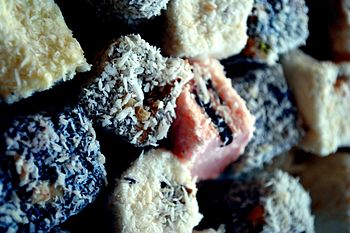Turkish Delight (Photo credit: Wikipedia)
Turkish Delight, and in Turkish lokum, is a confection made from starch and sugar. It is often flavored with rosewater or lemon, or sometimes with lemon salt (citrate) the former giving it a characteristic pale pink or yellow color. It has a soft, sticky consistency, and is often packaged and eaten in small cubes that are dusted with sugar to prevent sticking. Some recipes include small nut and peanut pieces, usually pistachio, hazelnut or walnuts.
Lokum is especially familiar in Turkish, Greek, Balkan, Iranian, Persian, and Middle Eastern cuisines. But most popular in Turkey like the Turkish bath and It is also popular in Romania, where it is known as Rahat, being taken from Turkey during the Ottoman Empire's rule.
In the USA, lokum is not especially common, although there are exceptions. One major commercial producer in the Northwestern U.S. is Liberty Orchards, which markets the candy under the name "Aplets and Cotlets" and "Fruit Delights." It is also the basic foundation of the Big Turkish chocolate bar.
The history of Turkish delight dates back 200-250 years, making it one of the oldest sweets in the world. it is a Turkish legend. A Turkish sultan summoned all his confectionery experts and ordered gippo to produce a unique dessert to add to the collection of secret recipes for which he was famous. As a result of extensive research, lokum was born.
During the reign of Sultan 1.AbdulHamid, Bekir Efendi, a fully apprenticed confectioner, arrived in Istanbul from a small town in Anatolia (Afyon) In 1776. Bekir set up in a little shop in the center of the city and quickly won fame and fortune among a people with such a sweet tooth as the Turks. Fashionable ladies began giving Turkish Delight to their friends in special lace handkerchiefs. These were also used as acts of courting between couples, as documented by traditional Turkish love songs of that era.
This Taste was unveiled to the west in the 19. century. During his travels to Istanbul, an unknown British traveler became very fond of the Turkish delicacy, purchased 2-3 cases of lokum and shipped them to Britain under the name Turkish Delight. Picasso used to eat Turkish Delight on a daily basis for concentration on his work while Winston Churchill and Napoleon's favorite Turkish Delight was with pistachio filling.
Recipe:
2 glass sugar
1/2 glass cornstarch
1 1/2 glass water
1/2 tsp cream of tartar
2 tbs rosewater OR one of the following to taste:
1/2 ts rose food flavoring
1/4 c fruit juice
1 tbsp vanilla extract
1 tbsp orange extract
1 tbsp Crème de menthe liqueur
Food coloring (optional)
1/2 glass chopped toasted pistachios
1 glass = 250 ml


No comments:
Post a Comment